
Banff and Buchan is a committee area of the Aberdeenshire Council, Scotland. It has a population of 35,742. Fishing and agriculture are important industries, together with associated processing and service activity.
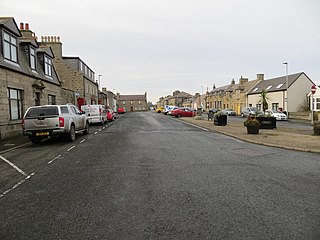
Rosehearty is a settlement on the Moray Firth coast, four miles west of the town Fraserburgh, in the historical county of Aberdeenshire in Scotland. The burgh has a population of approximately 1,300 with about 25 per cent of pensionable age.

Peterhead is a town in Aberdeenshire, Scotland. It is Aberdeenshire's biggest settlement, with a population of 18,537 at the 2011 Census. It is the biggest fishing port in the United Kingdom for total landings by UK vessels, according to a 2019 survey.
The Frasers of Philorth are a Scottish lowland family, originally from the Anjou region of France. Castle Fraser, their family seat, is in Sauchen, Aberdeenshire, Scotland. Since the time of Alexander Fraser, 11th Lord Saltoun, the heads of the Philorth family are the Lords Saltoun. The current head of the Frasers of Philorth is Flora Fraser, 21st Lady Saltoun, who is Chief of the Name and Arms of Clan Fraser since 1 May 1984, by decree of the Court of the Lord Lyon. The family's arms are "azure, three cinquefoils argent"—three silver strawberry flowers on a field of blue. The heraldic cinquefoil is a stylized five-point leaf; the cinquefoils which appear on the Fraser of Philorth coat-of-arms are specifically strawberry flowers. Only the Lady or Lord Saltoun is permitted to display these arms plain and undifferenced.

Whinnyfold or Whinneyfold is a small coastal village at the southern end of the Bay of Cruden in Aberdeenshire, Scotland.
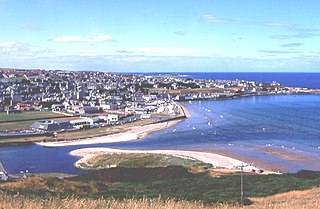
Banff is a town in the Banff and Buchan area of Aberdeenshire, Scotland. It is situated on Banff Bay and faces the town of Macduff across the estuary of the River Deveron. It is a former royal burgh, and is the county town of the historic county of Banffshire.

Buchanhaven is a village in Aberdeenshire, Scotland, dating to around 1739. It is one mile north of Peterhead town centre, and near to the mouth of the River Ugie. It has its own school, Buchanhaven Primary School, which caters for children in Buchanhaven and the nearby Waterside estate. It is also the home of Buchanhaven Hearts F.C.
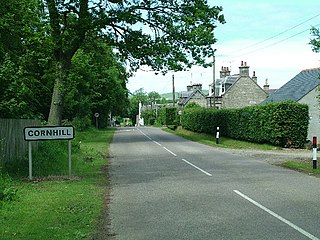
Cornhill is a small village close to Banff, Aberdeenshire, Scotland. It lies 5 miles (8.0 km) to the south of Portsoy. The village was originally a burgh of a feudal barony and is now a farming community.

Fordyce is a village in Aberdeenshire, Scotland that is slightly inland from the point where the Burn of Fordyce meets the sea between Cullen and Portsoy. It has existed since at least the 13th century. In 1990, Charles McKean wrote that Fordyce was "a sheer delight to discover, concealed as it is from the passing eye by hills and rolling countryside".

Cairnbulg Castle is a z-plan castle situated in Cairnbulg, Aberdeenshire, Scotland. It was described by W. Douglas Simpson as one of the nine castles of the Knuckle, referring to the rocky headland of north-east Aberdeenshire. It stands by the River Philorth and was originally known as Philorth Castle. The 17th-century Philorth Castle, an L-plan house consisting of a sizeable crow-stepped block, was demolished after a fire in 1915.
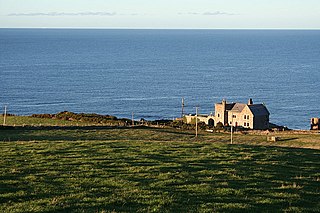
Dundarg Castle is a ruined castle about 2 kilometres (1.2 mi) north-northeast of New Aberdour, Aberdeenshire, Scotland, built within the ramparts of an earlier Iron Age promontory fort. It was described by W. Douglas Simpson as one of the nine castles of the Knuckle, referring to the rocky headland of north-east Aberdeenshire, and by Charles McKean as "Scotland's answer to Tintagel". It became a small Celtic monastery for a period.

Pitsligo Castle is a ruined castle half a mile east of Rosehearty, Aberdeenshire, Scotland. Modified in the 1570s by the Forbes of Druminnor, it was described by W. Douglas Simpson as one of the nine castles of the Knuckle, referring to the rocky headland of north-east Aberdeenshire.

Brethren Meeting House is a Category C listed building at 26 Gordon Street in Boddam, Aberdeenshire, Scotland. It was formerly a late-Victorian-era Wesleyan church. A bellcote is on the gable, without a bell but with a "spiky" finial in place.
32 Broad Street is a Category B listed building at 32 Broad Street in Peterhead, Aberdeenshire, Scotland. It was built in 1858. Originally a Union Bank of Scotland, it is now home to a Bank of Scotland.
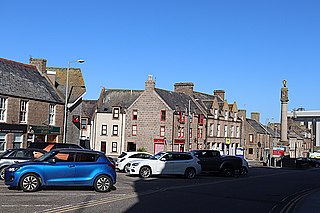
The Reform Monument is a Category B listed monument on Broad Street, at its junction with Longate, in Peterhead, Scotland, built in 1833. A Roman doric column, it is surmounted by arms of Earl Marischal, inspired by the gateway of Inverugie Castle.

The Bath House is a Category B listed building in Peterhead, Aberdeenshire, Scotland. Located at 7 Bath Street, it dates to around 1812.
Aberdour House is Category A listed country house in New Aberdour, Aberdeenshire, Scotland. Dating to around 1740, it was built by John Forbes, of Knappernay.

Sandford Lodge is a Category B listed building in Peterhead, Aberdeenshire, Scotland. A former farmhouse, described by Charles McKean as a "miniature mansion house", it was built around 1800; today, only the shell of the building remains, after a fire in the early hours of 8 August 2015.
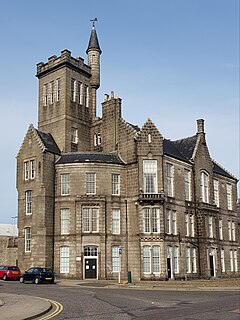
Dalyrmple Hall is a building in Fraserburgh, Scotland, standing on Dalyrmple Street at its junction with Station Brae. Category C listed, in the Scottish baronial style, it dates to 1881. Its architects were Aberdeen-based Jenkins & Marr.
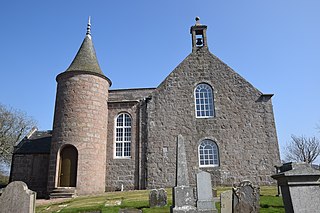
St Olaf's Church is a Category B listed building in Cruden, Aberdeenshire, Scotland, dating to 1776. It is of Church of Scotland denomination.




















